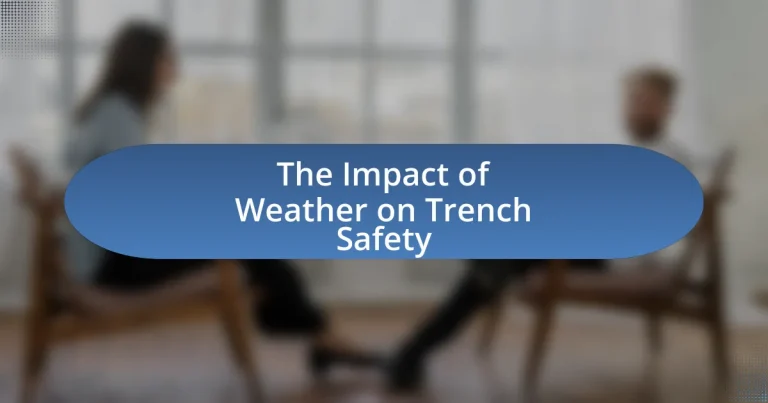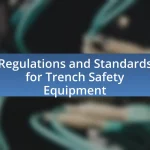The article focuses on the impact of weather on trench safety, highlighting how various weather conditions such as rain, extreme temperatures, and high winds can compromise soil stability, visibility, and worker safety. It emphasizes the importance of monitoring weather patterns to prevent trench collapses, which are a leading cause of fatalities in excavation work. Key factors discussed include the effects of water accumulation, temperature fluctuations, and the necessity of implementing effective drainage systems and protective measures. The article also outlines best practices for preparing workers for adverse weather and ensuring ongoing safety during inclement conditions.
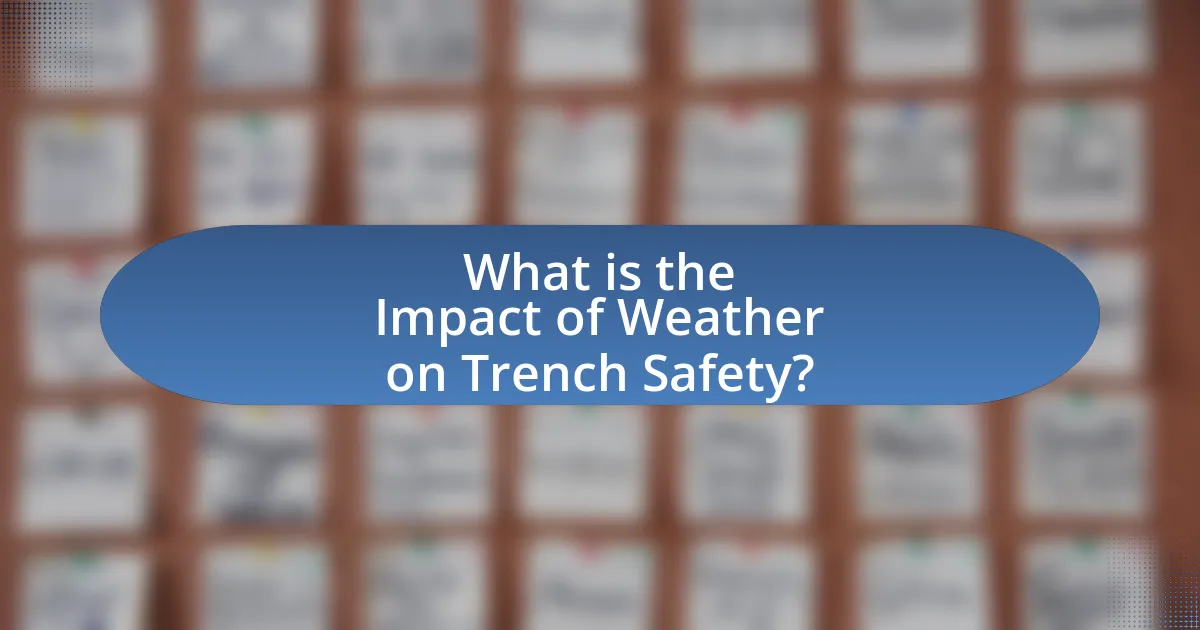
What is the Impact of Weather on Trench Safety?
Weather significantly impacts trench safety by influencing ground stability, visibility, and worker conditions. Rain can saturate soil, increasing the risk of cave-ins, while freezing temperatures can lead to frostbite and hypothermia among workers. Additionally, high winds can create hazardous conditions for equipment and materials. According to the Occupational Safety and Health Administration (OSHA), trench collapses are a leading cause of fatalities in excavation work, with wet conditions being a major contributing factor. Therefore, monitoring weather conditions is crucial for ensuring trench safety and implementing necessary precautions.
How does weather influence trench conditions?
Weather significantly influences trench conditions by affecting soil stability, moisture levels, and visibility. Rain can saturate the soil, increasing the risk of collapse and making the trench walls unstable. For instance, heavy rainfall can lead to muddy conditions, which can compromise the integrity of the trench and pose hazards to workers. Additionally, extreme temperatures can cause soil to expand or contract, further impacting stability. Wind can also affect visibility and create hazardous working conditions. According to the Occupational Safety and Health Administration (OSHA), proper weather assessments are crucial for maintaining trench safety, as adverse weather conditions can lead to accidents and injuries on construction sites.
What specific weather factors affect trench safety?
Specific weather factors that affect trench safety include heavy rainfall, extreme temperatures, high winds, and freezing conditions. Heavy rainfall can lead to water accumulation in trenches, increasing the risk of collapse and drowning hazards. Extreme temperatures can cause heat stress for workers or lead to soil instability. High winds can create dangerous conditions for overhead work and equipment stability. Freezing conditions can lead to frostbite for workers and make the soil more susceptible to collapse. These factors are critical in assessing trench safety and ensuring proper precautions are taken to mitigate risks.
How do temperature fluctuations impact trench stability?
Temperature fluctuations significantly impact trench stability by causing soil expansion and contraction, which can lead to increased risk of collapse. When temperatures rise, soil moisture can evaporate, leading to drying and shrinkage, while lower temperatures can cause soil to freeze and expand. This cycle of expansion and contraction weakens the structural integrity of the trench walls. Research indicates that unstable soil conditions, exacerbated by temperature changes, can increase the likelihood of trench failures, as evidenced by incidents reported in construction safety studies.
Why is understanding weather patterns crucial for trench safety?
Understanding weather patterns is crucial for trench safety because adverse weather conditions can lead to hazardous situations such as flooding, soil instability, and increased risk of cave-ins. For instance, heavy rainfall can saturate the soil surrounding a trench, significantly reducing its structural integrity and increasing the likelihood of collapse. According to the Occupational Safety and Health Administration (OSHA), trench collapses are a leading cause of fatalities in excavation work, emphasizing the need for awareness of weather conditions. By monitoring weather forecasts and patterns, workers can implement safety measures, such as shoring or sloping, to mitigate risks associated with changing environmental conditions.
What are the potential risks associated with adverse weather conditions?
Adverse weather conditions pose several potential risks, including increased soil instability, reduced visibility, and heightened danger of flooding. Soil instability can lead to trench collapses, as saturated soil loses its structural integrity, increasing the likelihood of accidents. Reduced visibility during heavy rain or snow can impair workers’ ability to see hazards, leading to accidents or injuries. Additionally, flooding can create hazardous working conditions, making trenches unsafe and complicating rescue efforts. Historical data indicates that trench-related fatalities often spike during adverse weather events, underscoring the critical need for safety measures in such conditions.
How can weather forecasts aid in trench safety planning?
Weather forecasts can significantly aid in trench safety planning by providing critical information about potential weather-related hazards, such as heavy rainfall, high winds, or extreme temperatures. Accurate forecasts allow construction teams to anticipate adverse conditions that could lead to trench collapses or worker injuries. For instance, the National Weather Service reports that heavy rainfall can saturate soil, increasing the risk of trench failure. By monitoring forecasts, teams can schedule work during favorable weather conditions, implement protective measures like shoring or trench boxes, and ensure that workers are adequately prepared for changing conditions, thereby enhancing overall safety on the job site.
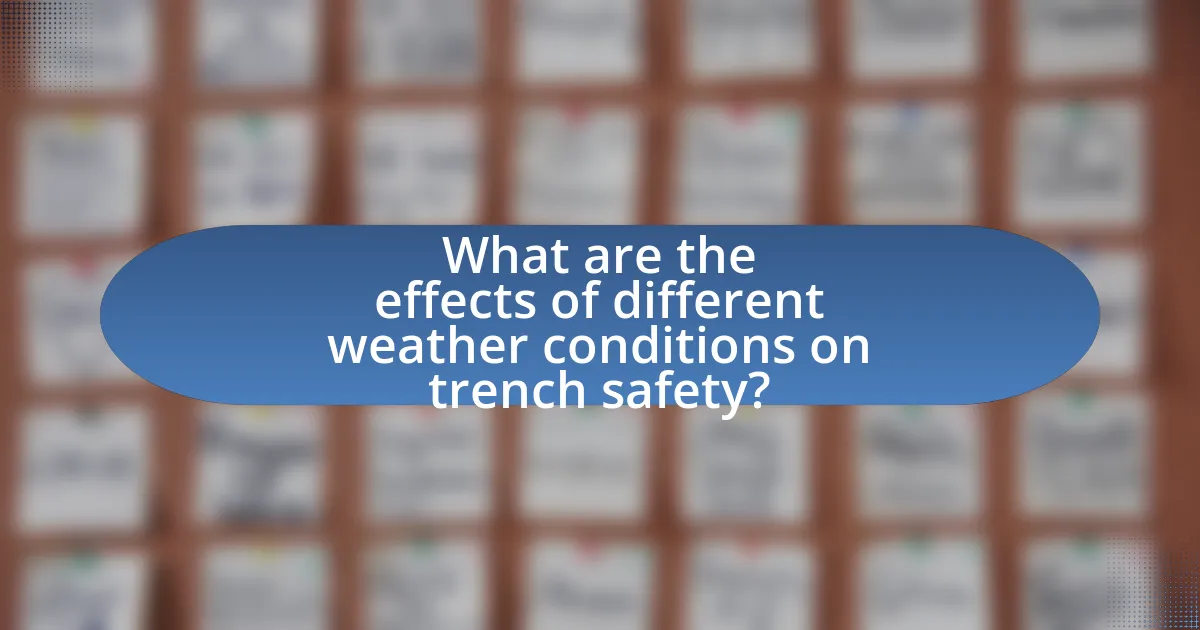
What are the effects of different weather conditions on trench safety?
Different weather conditions significantly affect trench safety by influencing soil stability, visibility, and worker conditions. For instance, heavy rainfall can saturate the soil, increasing the risk of cave-ins due to reduced cohesion. According to the Occupational Safety and Health Administration (OSHA), wet soil can lose up to 50% of its strength, making trenches more hazardous. Similarly, extreme temperatures can lead to heat stress or hypothermia among workers, impacting their ability to operate safely. Wind can also create dust or debris, reducing visibility and increasing the risk of accidents. Thus, understanding these weather effects is crucial for maintaining trench safety.
How does rain affect trench safety?
Rain significantly compromises trench safety by increasing the risk of trench collapse and creating hazardous working conditions. When rainwater accumulates in a trench, it can saturate the soil, reducing its stability and cohesion, which can lead to sudden collapses. According to the Occupational Safety and Health Administration (OSHA), wet soil is more prone to failure, and trenches deeper than five feet require protective systems when water is present. Additionally, rain can create slippery surfaces, increasing the likelihood of slips and falls for workers. Therefore, proper drainage and protective measures must be implemented during rainy conditions to ensure worker safety in trenches.
What are the dangers of water accumulation in trenches?
Water accumulation in trenches poses significant dangers, including increased risk of trench collapse, drowning hazards for workers, and the potential for waterborne diseases. The weight of accumulated water can destabilize trench walls, leading to cave-ins, which are a leading cause of fatalities in excavation work. According to the Occupational Safety and Health Administration (OSHA), trench collapses can occur within seconds, making it critical to manage water effectively. Additionally, stagnant water can create breeding grounds for mosquitoes, increasing the risk of diseases such as West Nile virus. Proper drainage systems and regular monitoring are essential to mitigate these risks.
How can drainage systems mitigate rain-related risks?
Drainage systems mitigate rain-related risks by effectively managing excess water runoff, thereby reducing flooding and soil erosion. These systems, which include ditches, pipes, and retention basins, are designed to channel rainwater away from vulnerable areas, such as construction sites and trenches. For instance, a study by the U.S. Geological Survey found that proper drainage can decrease surface water accumulation by up to 80%, significantly lowering the risk of trench collapses and worker hazards during heavy rainfall. By maintaining soil stability and preventing waterlogging, drainage systems play a crucial role in enhancing trench safety during adverse weather conditions.
What role does wind play in trench safety?
Wind plays a significant role in trench safety by influencing the stability of the trench and the surrounding soil. High winds can lead to increased erosion, which may undermine trench walls and create hazardous conditions for workers. According to the Occupational Safety and Health Administration (OSHA), wind speeds exceeding 20 miles per hour can pose risks, as they may destabilize protective systems and increase the likelihood of collapses. Therefore, monitoring wind conditions is essential for maintaining a safe working environment in trench operations.
How can strong winds create hazards for workers in trenches?
Strong winds can create hazards for workers in trenches by increasing the risk of falling debris and reducing visibility. When winds are strong, they can dislodge materials from nearby structures or trees, posing a threat to workers below. Additionally, strong winds can cause dust and debris to become airborne, impairing visibility and making it difficult for workers to see hazards or communicate effectively. According to the Occupational Safety and Health Administration (OSHA), environmental conditions, including wind, must be assessed to ensure worker safety, highlighting the importance of monitoring weather conditions in trench work.
What precautions should be taken during windy conditions?
During windy conditions, it is essential to secure all loose materials and equipment to prevent them from being blown away or causing injury. Wind can create hazardous situations, especially in trench work, where flying debris can lead to accidents. Additionally, workers should wear appropriate personal protective equipment, such as hard hats and safety goggles, to shield against potential impacts from airborne objects. According to the Occupational Safety and Health Administration (OSHA), maintaining a safe work environment during adverse weather conditions is crucial for preventing workplace injuries.
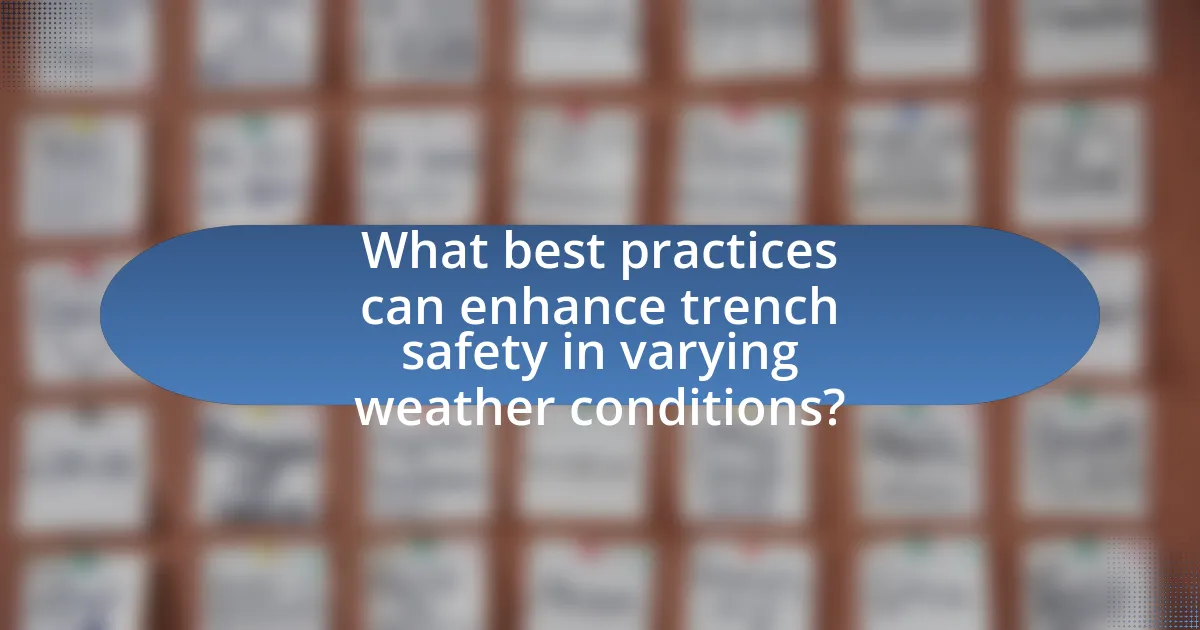
What best practices can enhance trench safety in varying weather conditions?
To enhance trench safety in varying weather conditions, implement effective drainage systems to prevent water accumulation and ensure proper shoring techniques to stabilize trench walls. Effective drainage systems, such as sump pumps and ditches, mitigate the risk of flooding, which can lead to trench collapses; according to the Occupational Safety and Health Administration (OSHA), water accumulation is a significant hazard in trenching operations. Proper shoring techniques, including the use of trench boxes or hydraulic shores, provide structural support, especially in wet conditions where soil becomes loose and unstable. Additionally, monitoring weather forecasts and adjusting work schedules accordingly can prevent unsafe conditions from developing.
How can workers prepare for adverse weather when working in trenches?
Workers can prepare for adverse weather when working in trenches by implementing several key strategies. First, they should monitor weather forecasts to anticipate conditions such as rain, snow, or extreme temperatures. This proactive approach allows workers to schedule trench work during favorable weather. Additionally, workers should use protective gear, including waterproof clothing and insulated layers, to maintain body temperature and prevent hypothermia or heat-related illnesses.
Furthermore, workers should ensure proper drainage systems are in place to prevent water accumulation in trenches, which can lead to hazardous conditions. According to the Occupational Safety and Health Administration (OSHA), maintaining dry conditions in trenches is critical for safety. Lastly, workers should have an emergency plan that includes evacuation routes and communication methods in case of sudden weather changes. These measures collectively enhance safety and reduce risks associated with adverse weather conditions in trench work.
What safety gear is essential for different weather scenarios?
Essential safety gear for different weather scenarios includes waterproof clothing and boots for rain, insulated gear for cold weather, and sun protection gear for hot weather. Waterproof clothing and boots prevent hypothermia and keep workers dry during wet conditions, while insulated gear helps maintain body heat in cold environments, reducing the risk of frostbite. Sun protection gear, such as hats and UV-blocking clothing, is crucial in hot weather to prevent heat-related illnesses. These safety measures are supported by guidelines from organizations like OSHA, which emphasize the importance of appropriate gear to mitigate weather-related risks in trench safety.
How can training improve awareness of weather-related risks?
Training can improve awareness of weather-related risks by providing individuals with essential knowledge and skills to recognize and respond to hazardous conditions. Structured training programs often include information on identifying severe weather patterns, understanding their potential impacts on trench safety, and implementing safety protocols. For instance, the Occupational Safety and Health Administration (OSHA) emphasizes the importance of training in recognizing environmental hazards, which can significantly reduce the likelihood of accidents. Furthermore, studies have shown that workers who receive comprehensive training are more likely to adhere to safety guidelines during adverse weather conditions, thereby minimizing risks associated with trench work.
What are the common troubleshooting strategies for weather-related trench issues?
Common troubleshooting strategies for weather-related trench issues include monitoring weather forecasts, implementing proper drainage systems, and using protective barriers. Monitoring weather forecasts allows for proactive planning to avoid working during adverse conditions, which can lead to trench collapses. Implementing proper drainage systems helps to manage water accumulation, reducing the risk of soil erosion and instability. Using protective barriers, such as trench boxes or shoring, provides additional support to the trench walls, mitigating the effects of heavy rain or flooding. These strategies are essential for maintaining trench safety and preventing accidents related to weather conditions.
How can teams effectively respond to sudden weather changes?
Teams can effectively respond to sudden weather changes by implementing a proactive weather monitoring system and establishing clear communication protocols. Proactive monitoring allows teams to receive timely alerts about impending weather conditions, enabling them to take necessary precautions. For instance, the National Oceanic and Atmospheric Administration (NOAA) provides real-time weather updates that can be integrated into team operations. Clear communication protocols ensure that all team members are informed of changes and can act swiftly, such as evacuating a trench site during severe weather to prevent accidents. These strategies are essential for maintaining safety and minimizing risks associated with trench work during adverse weather conditions.
What steps should be taken to ensure ongoing safety during inclement weather?
To ensure ongoing safety during inclement weather, implement proactive measures such as monitoring weather forecasts, securing trench sites, and providing adequate drainage. Monitoring weather forecasts allows for timely awareness of severe conditions, enabling workers to evacuate or halt operations as necessary. Securing trench sites involves reinforcing walls and ensuring that equipment is stable to prevent collapses during heavy rain or wind. Providing adequate drainage prevents water accumulation, which can lead to hazardous conditions such as mudslides or trench flooding. These steps are essential for maintaining safety standards and minimizing risks associated with adverse weather conditions in trench work.
